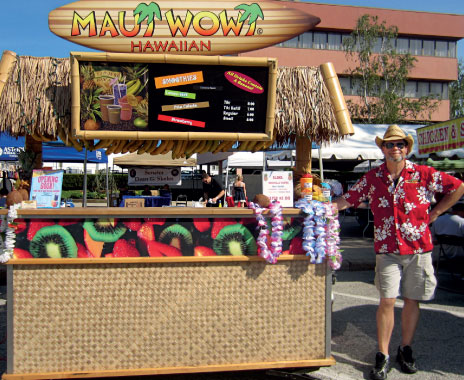Forget the rock-hard pretzels and suspicious-looking hot dogs that cart vendors were once known for. Nowadays, the mobile foodservice space is populated by specialty coffee concepts, gourmet popcorn carts, and Korean barbecue on wheels. And business is booming for these operators as they look to economize and get in front of consumers in new ways.
Until recently, mobile foodservice had flown under the radar, says Aaron Allen, CEO of restaurant consulting firm Aaron Allen & Associates. But the industry is changing: The traditional restaurant business is only growing more competitive, consumers are increasingly on the go, and the snack occasion is peaking in popularity.
“Those things all kind of contribute toward this idea of nontraditional foodservice locations,” he says. “And there’s billions of dollars to be had.”
The rise of the food truck may be the biggest buzz in mobile foodservice, but the trend has also lent itself to other operations that are easy to franchise and expand. Take, for example, Doc Popcorn, the 90-unit chain of popcorn kiosks, stores, and carts. The Boulder, Colorado–based chain sees some of its best sales not at malls or brick-and-mortar stores, but on weekends at gymnastic meets, cheerleading conventions, and volleyball tournaments. With half of the chain’s units operating as mobile carts, operators can take their freshly popped popcorn into trade centers, high schools, and professional sporting venues—all places filled with captive, hungry audiences.
“They can do as much business in three days as mainline stores or kiosks do in a week,” says Rob Israel, CEO of Doc Popcorn. “It’s crazy.”
Of course, there are some limits to the carts. Instead of offering seven or eight flavors like its main stores do, Doc Popcorn’s PopCarts can only offer three.
But even with the product and stock limitations, the carts can replicate the unique brand experience, Israel says. Doc Popcorn positions itself as offering a better-for-you snack, one made with high-quality ingredients like corn oil and natural flavorings. Israel says Doc Popcorn offers consumers a higher-quality product than what’s served out of the usual popcorn cart or concession stand.
Though the movement toward better-for-you foods has contributed to the growth of mobile foodservice, with more operators jumping into the space in the last decade, some concepts, like 33-year-old Maui Wowi Hawaiian Coffees & Smoothies, were early adopters of the business model. Of the brand’s 450 operating units, 400 are mobile. “We’re on wheels,” says CEO Mike Weinberger. “We can go wherever.”
While some operators may struggle to pare down the menu and equipment when adapting to mobile carts, Maui Wowi didn’t face that problem, as the concept was initially built around the events business, Weinberger says.
Maui Wowi’s menu includes a lineup of specialty coffees and fruit smoothies, which benefit from a health halo, as they offer two servings of fruit and are made with fresh yogurt. Even among captive audiences, consumers are becoming savvier and more health conscious, Weinberger says. That doesn’t mean they won’t grab a corn dog or funnel cake at the county fair, he says, but they should have choices.
“People aren’t going to go somewhere else to get their food or drink,” he says. “So they’re going to choose from whatever is there. So why not give them a healthy option?”
For all of Maui Wowi’s expertise in mobile, there’s one thing the company can’t control: weather. In times of rain or snow, the cart operation may be preferable to the food truck, as it opens up indoor event opportunities, he adds.
Kona Ice franchisees have found the brand’s mobile units, called Kona Mini, a great way to beef up wintertime sales. Because the carts can fit through a standard doorway, they can go where a truck can’t, which allows Minis to service winter sports events like wrestling tournaments.
“We’re not getting as much revenue, but it is revenue in the off season,” says CEO Tony Lamb. “But it’s nothing compared to having your truck parked at the county fair.”
The Mini was invented as a response to what Lamb calls “explosive growth.” Corporate found that 70 percent of franchisees were buying a second truck within the first two years. Now the company has 560 trucks, 40 trailers, 25 kiosks, and 165 carts.
At about $20,000, the Mini is cheaper than investing in a truck, which costs about $100,000.
Kona Ice franchisees must begin with at least one truck, Lamb says, because the Minis aren’t a good first step into the market. With more flavors and freezer space for products, the truck operation boasts wider offerings.
“The big difference is the branding,” he says. “The footprint of a truck and the presence of a truck at a festival or event is big. It has music. It lights up. … The Mini just doesn’t have the presence. That’s why the Mini is great after you’ve established your brand. I know it wouldn’t be a great starting product, because people don’t get the size and scope of it all.”








